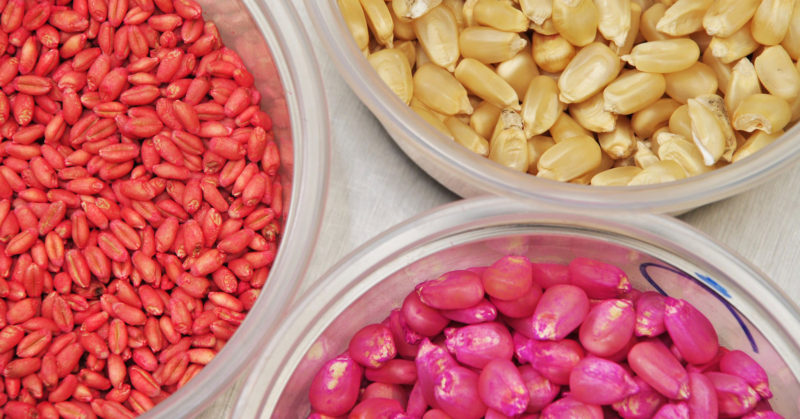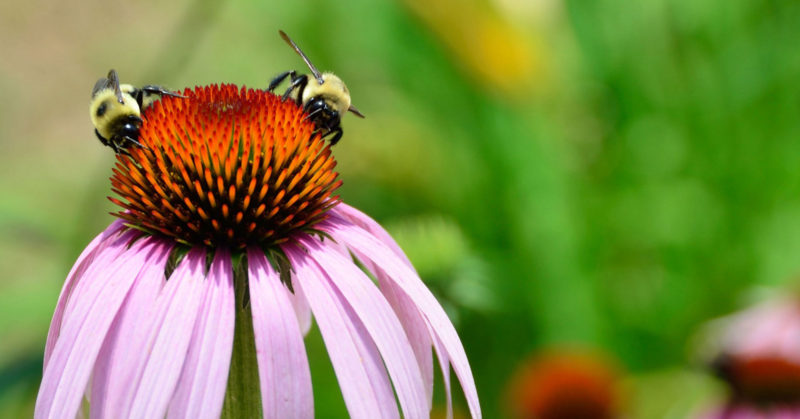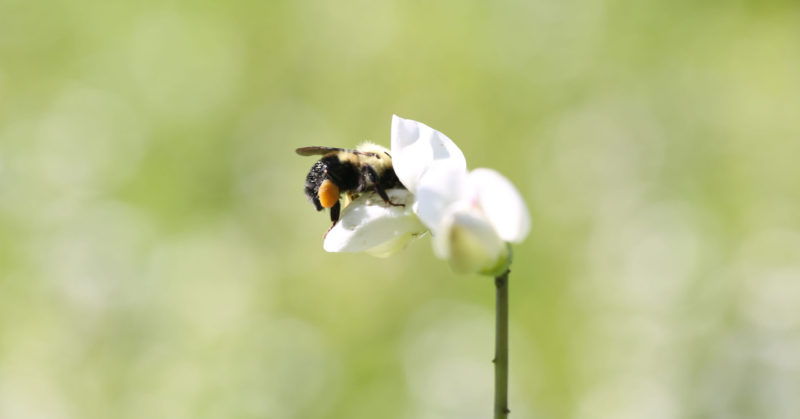This article was written by our 2022 intern from the UIC Freshwater Lab, Sam Cangelosi. You can read more about Sam and the internship here.
Each year farmers sow brightly dyed seeds into millions of acres across the United States heartland. These seeds range in an array of colors from bright pink and cyan to neon purple, as a caution to those handling them that a coating of toxic pesticide surrounds the seed. The most common seed coatings are a class of pesticides known as neonicotinoids. Since their introduction in the late 90s, their use has proliferated within the agricultural sector due to pesticide manufacturers and seed distributors pushing seed treatments when farmers buy seeds.1 Seed companies incentivize the use of treated seeds by offering replant insurance, whereby seed companies will pay up to 100% of the cost to replant crops damaged by insects. This leaves growers using untreated seeds without insurance, a risk that few growers are willing to take with their livelihoods in an industry already subject to the volatility of weather and world markets.


Further facilitating the extensive use of neonicotinoids is a legislative loophole found in the Federal Insecticide, Fungicide, and Rodenticide Act (FIFRA). FIFRA authorizes EPA as the regulatory agency to spell out the intricacies of the law signed by congress, wherein section 152.25 of Title 40, EPA creates an exemption for treated articles. In its exemption, EPA authorizes that so long as a pesticide is used to protect an article or substance, it is exempted from all provisions within FIFRA. This exemption grants treated articles unprecedented freedom from the law under FIFRA, as well as regulatory agencies and their scrutiny. This freedom has allowed companies such as Bayer and Syngenta to make billions off seeds treated with neonicotinoids over the years, with minimal investigation into the disastrous effects of these pesticides on the environment.
How Neonicotinoids Work
Neonicotinoids are highly effective pesticides from a pest management standpoint; it takes such minute concentrations, as little as a few parts per billion to have lethal effects on insects. To visualize this, imagine a strand of toilet paper stretching from New York to London; one sheet in that transatlantic stretch would be equivalent to the amount of neonicotinoid needed to effectively kill pests. The acute toxicity achieved with a quantifiable fraction required from other pesticides on the market make neonicotinoids viable to farmers as an effective pest deterrent and economically enticing.2 Neonicotinoids, however, come with hidden costs and leave many unanswered questions surrounding their systemic and persistent properties in plants and the environment, their solubility in water, and the damage they cause to invertebrates, especially pollinators, and aquatic ecosystems.

Neonicotinoids work by targeting the nervous system of insects. Acute poisoning binds the nerve cells in insects resulting in uncontrollable twitching, which precedes paralysis and eventually death. Sublethal effects of neonicotinoids on insects can include flight and navigation problems, slower learning of new tasks, reduced fertility, and other issues affecting an insect’s ability to forage. In the case of bees, they also affect hive productivity. The application of these pesticides, mainly through the use of treated seeds, affects between 79-100% of conventional corn fields and between 34-44% of soybean fields, with some estimates pushing soy above 50%. Their use, however, is not limited to just these two crops; neonicotinoids are currently the most widely used pesticides in the world. The total acreage on which these pesticides are used is difficult to estimate; with experts pointing toward a number in the tens of millions via seeds wrapped in a veneer of neonics and spray treatments.3
Neonicotinoids are systemic pesticides, meaning that as a plant grows from a pesticide-coated seed, the pesticide is transferred throughout the plant and inhabits every part of its system. From the stalk, leaves, pollen, and nectar, the neonicotinoid will become persistent within the plant for months. In the case of some trees, shrubs, and vines, persistence can extend to nearly half a decade. The traits expressed in plants by neonicotinoids are incredibly effective at killing pests but also non-target species. The pesticide cannot differentiate between a harmful insect and a beneficial one. Similarly, beneficial insects such as pollinators cannot detect a neonicotinoid within the pollen of a plant. This can lead to lethal effects for an organism and the potential collapse of native pollinators due to the widespread use of neonicotinoids in agriculture.4
Impacts on the Landscape and to Pollinators
A driving force behind native pollinator collapse is the extensive use of neonicotinoids which has left many areas where pollinators would thrive contaminated with a lethal pesticide. Secondarily, the sheer loss of natural habitat due to monocropping leads to decreased colonies from a mere lack of space to create a home. Monocropping is an industrial agriculture practice that destroys the natural ecology of an area and replaces it with a single stock crop, resulting in habitat destruction. Estimates in the United States place 180.3 million acres of land – roughly the size of Illinois, Michigan, Iowa, Ohio, Kentucky, and Indiana combined – devoted to this style of agriculture in corn and soy alone.5 This devastation of natural ecology removes local flora, which pollinators have coevolved with over millennia to work in tandem and ensure mutual survival. Replacement of the local flora with corn and soy leaves pollinators with no food or habitat, and populations subsequently collapse.
The longevity of neonicotinoids assists in facilitating population collapse and is another issue that farmers should consider with the broadspectrum use of neonicotinoids. Their ability to persist in the environment long after their application, like in plants, is extraordinarily long, ranging from months to years.6 The persistence of these pesticides in soils leads to a higher risk of exposure to nearly 70% of native bee species that are ground-nesting, resulting in possible acute exposure to species that call the soil home.7 These native pollinators provide ecosystem services or perks for free to the environment, such as pollination and natural pest prevention via predation. With close to 35% of the world’s food production reliant upon pollinators, the loss of these species could result in the agriculture sector losing hundreds of billions of dollars annually and cause further food shortages in already food-stressed and underserved communities.8
Additionally, neonicotinoids have a low solubility in soils, yet a very high solubility in water, allowing these pesticides to migrate during rain events. As a result, the pesticide finds many pathways into subsurface soils and groundwater sources, where exposure to aquifer and drinking water systems show worrying trends for neonicotinoid metabolites in drinking water.9 A metabolite is the breakdown product of metabolism. In the case of neonicotinoid-based metabolites, breakdown occurs through microbial and abiotic processes resulting in a potential for significantly higher toxicity in mammals. For example, the metabolites desnitro-imidacloprid and descyano-thiacloprid are respectively 300 and 200 times more toxic to mammals and significantly more toxic than imidacloprid, a commonly used neonicotinoid.10 Neonicotinoid metabolite reaction to water treatment processes may also increase the chance that the metabolites morph further, into new forms of chlorinated disinfection byproducts. These byproducts are untested and untracked and could pose severe carcinogenic or genotoxic risks to human health.11

Regulations (or Lack Thereof) on Neonicotinoids
The European Union limited the use of neonicotinoids in response to their potential contribution to bee and other pollinator population declines. In the United States, few measures are in place to restrict the use of neonicotinoids. In an exceptional case, the U.S. Fish and Wildlife Service pledged to phase out all use of neonicotinoids in National Wildlife Refuges in 2016. However, Trump-era policies in the FWS have left the pledge unfulfilled, with challenges from environmental groups going unheard.12 As a result of federal inaction, regulation is largely left up to state and local governments. But high levels of neonicotinoid use can likely be correlated with regulatory capture of state and local agencies by agricultural and chemical interests, which results in little to no restrictions. In June 2022, EPA released biological evaluations confirming that three of the most widely used neonicotinoids harm endangered species and their critical habitat.13 The findings will force EPA to critically examine these pesticides’ dangers to species and habitats as the agency continues to assess their use in the United States. Unfortunately, with minimal regulations, neonicotinoids remain persistent and widespread across the landscape.
Environmental Tragedy in Mead, Nebraska
Neonicotinoid-treated seeds have resulted in catastrophic consequences when utilized in ethanol production, as the small town of Mead, Nebraska learned first hand. Mead is a rural community with a population of 585 and lies approximately 35 miles west of the state capital Omaha. In 2007, E3 Biofuels opened the first ethanol plant to use closed-loop production systems. The project was short-lived, however, and after filing for bankruptcy, E3 shuttered the plant months after beginning operations. When AltEn acquired the plant years later, practices shifted toward intaking neonicotinoid-treated seed for use in ethanol production. At the AltEn plant, the waste byproduct of this practice, called “wet cake,” was found to contain concentrations of the pesticide 85 times higher than the threshold for neonicotinoids. The plant amassed stockpiles of this wet cake, causing concerns among locals who complained of the ethanol plant’s stench; the plant closed after a series of failed inspections for refusing to clean up the massive piles of toxic wet cake. Still, it was not until a pipe burst in early 2021 after the plant had shuttered that the town became aware of the magnitude of issues surrounding the ethanol plant.14 The burst pipeline sent 4 million gallons of wastewater into the local watershed contaminating rivers and streams for miles around the plant. To this day, the contamination is widespread, with state and federal efforts underway to clean the mess. However, no permanent solutions exist to reprieve the locals of the turmoil AltEn has left behind.15

Policymakers must address the use of treated seeds in ethanol production, as AltEn’s mishandling of the byproduct has resulted in an expensive and environmentally devastating cleanup. In addition, AltEn has said that its Nebraska facility took in nearly 98% of the nation’s leftover treated seeds, leaving worrying questions about the pathways for disposal those displaced seeds are now taking.16 The events in Mead pushed Nebraska to take action by passing a bill in 2022 that bans the use of treated seeds in ethanol production.17 However, other states, such as Minnesota, have encountered legislative hurdles from state legislators, while Illinois has a bill sitting dead in committee.18 As a result, oversight of this practice remains limited, and it is difficult to tell what course leftover neonicotinoid-treated seeds take.
Solutions
Moving forward, EPA has a multitude of issues it must settle regarding neonicotinoid-treated seeds. In a proposed settlement with The Center for Food Safety and Pesticide Action Network, EPA is compelled to decide by September 30th whether it will proceed in drafting regulations for pesticide-treated seeds. Informing its decision should be the biological evaluations completed by the agency finding significant harm to nearly three-quarters of endangered wildlife. Neonicotinoid use in agriculture has become a broad spectrum approach in terms of application. Farmers apply neonicotinoids regardless of pest issues as the pesticide coating surrounds every seed they plant in a dusty sheath without taking stock of any pest issues. Agricultural and chemical companies profiting from neonicotinoid-treated seeds are the forces ingraining these broad-spectrum practices. By shifting away from broad-spectrum practices to an integrated pest management approach, pesticide application would involve targeting threats in real-time with far less utilization of chemicals compared to current trends, alleviating some of the burden pushed on wildlife and natural habitats by agriculture.







